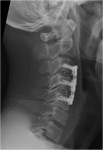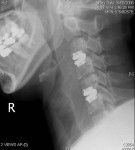When to consider surgery for neck pain treatment?
If the patient has an obvious structural abnormality (on X-rays and MRI), or they’ve failed to improve after at least twelve weeks of therapy and medications, then surgery is an option. Failure to improve may imply continuing pain, inability to reduce pain medication dosage, and disturbance in daily activities of living. In some cases, there are obvious nerve issues e.g. numbness and/or weakness that surgery may be the only option.
The thing that’s nice about cervical spine surgery is that it is generally successful, the postoperative pain is mild, and the recovery period is relatively short. Obviously most people like to avoid an operation if they can and if it can be healed with non surgical neck treatment. But often times, if we cannot treat it conservatively, and the patient is having pain, disability, and limitation of activities, then neck surgery can offer relatively rapid and successful resolution of symptoms.
Types of Surgery Options
The best chance of a successful outcome is when the problem in your neck is clearly defined as the cause of your neck pain. For example, if your MRI shows a herniated cervical disc that is pushing on a specific nerve route, and the physical exam confirms this, then you would probably benefit from removal of the disc and decompression of the nerve route as your neck pain treatment.
Anterior Cervical Discectomy with Fusion

Anterior cervical discectomy and fusion (Figure 7) is an operation performed on the front of the neck to relieve pressure on one or more nerve roots, or on the spinal cord. The term is derived from the words anterior (front), cervical (neck), and fusion (joining the vertebrae with a bone graft).
When an intervertebral disc ruptures in the cervical spine, it puts pressure on one or more nerve roots (often called nerve root compression) or on the spinal cord, causing pain and other symptoms in the neck, arms, and even legs. In this operation, the surgeon reaches the cervical spine through a small incision in the front of the neck. After the muscles of the spine are spread, the intervertebral disc is removed and a bone graft is placed between the two vertebral bodies. Over time, this bone graft will create a fusion between the vertebrae it lies between.
A small cervical plate is used to stabilize the spine immediately after surgery, and also to decrease the chance that the bone graft might be dislodged or moved slightly from the position that it was placed in by the surgeon. Today, collars are typically worn for a shorter period of time after surgery than in the past, because of the use of the plates.
Anterior Cervical Corpectomy

Cervical corpectomy (Figure 8) is an operation to remove a portion of the vertebra and adjacent intervertebral discs for decompression of the cervical spinal cord and spinal nerves. In some patients, the cervical spinal canal can be narrowed by bone spurs arising from the back of the vertebral body or the ligament behind the vertebral bodies. In this situation it may be necessary to remove one or more vertebral body and the discs above and below to adequately decompress the spinal cord and/or nerve roots. A bone graft with metal plate and screws is used to reconstruct the spine and provide stability.
Anterior Cervical Discectomy and Artificial Disc Replacement

Artificial prosthetic cervical disc replacement (Figure 9) is a recent development in neck surgery, and is a good alternative to anterior discectomy and fusion. The advantages lie in the ability to replicate the mechanics of the normal disc at the treated level. This may reduce stresses that would otherwise be transmitted to adjacent spinal levels, as in cervical discectomy and fusion.
Most of the procedure is similar to anterior cervical discectomy and fusion, with the exception of the methods used to fill up the space after the disc removal is completed. Instead of using bone graft secured with plate and screws (fusion), an artificial joint comprised of titanium plates with a plastic joint in between will be placed and secured in the disc space.
Posterior Decompression (laminectomy or laminoplasty)

Sometimes, the spine surgeon may recommend operating from behind the neck (posterior). This is usually indicated if the patient has multiple levels of nerve and spinal cord compression. The objective of performing the posterior surgery is to increase the space available for the nerves and spinal cord. This can be done via minimally invasive laminectomy, whereby the bones (lamina) covering the spinal cord are removed. Sometimes, the surgeon may also elect to stabilize the levels decompressed by placing titanium screws at the back of the neck (fusion).
Laminoplasty (Figure 10) is another alternative to laminectomy, and it is also recommended when there is evidence of narrowing of the spinal canal at many levels. One prerequisite of performing this surgery is that the spine must not be crooked or in kyphosis, otherwise the nerve compression will still remain after surgery. This operation is performed from the back of the neck, after positioning the patient in the prone (face-down) position. The procedure, in simplicity, creates more space for the spinal cord by creating and opening a trap door in the laminae of the spine. The difference with laminectomy is that the laminae or bones at the back of the neck are preserved instead of removed, hence reducing the need for fusion. Nowadays, we have newer methods of securing the opened laminae via mini plates and screws, which do not span across the joints of the neck, thus preserving mobility of the neck.
Posterior Foraminotomy
Cervical foraminotomy is an operation to enlarge the space where a spinal nerve root exits the cervical spinal canal to relieve the symptoms of a “pinched nerve.”
This is often performed at the same time when the spine surgeon does laminectomy or laminoplasty. It is less often done as an isolated procedure.
Learn more about the Symptoms of Neck Pain, Causes of Neck Pain and Non-Surgical Treatment for Neck Pain.
For a comprehensive consultation of your neck problems to determine if you need surgery, contact us to make an appointment with our internationally experienced spine surgeon at Singapore Pinnacle Orthopaedic Group today.
Looking For A Reliable Neck Orthopaedic Specialist?
Fast Medical Attention, Transparent Fees
Make an appointment for comprehensive care for your neck problems!
